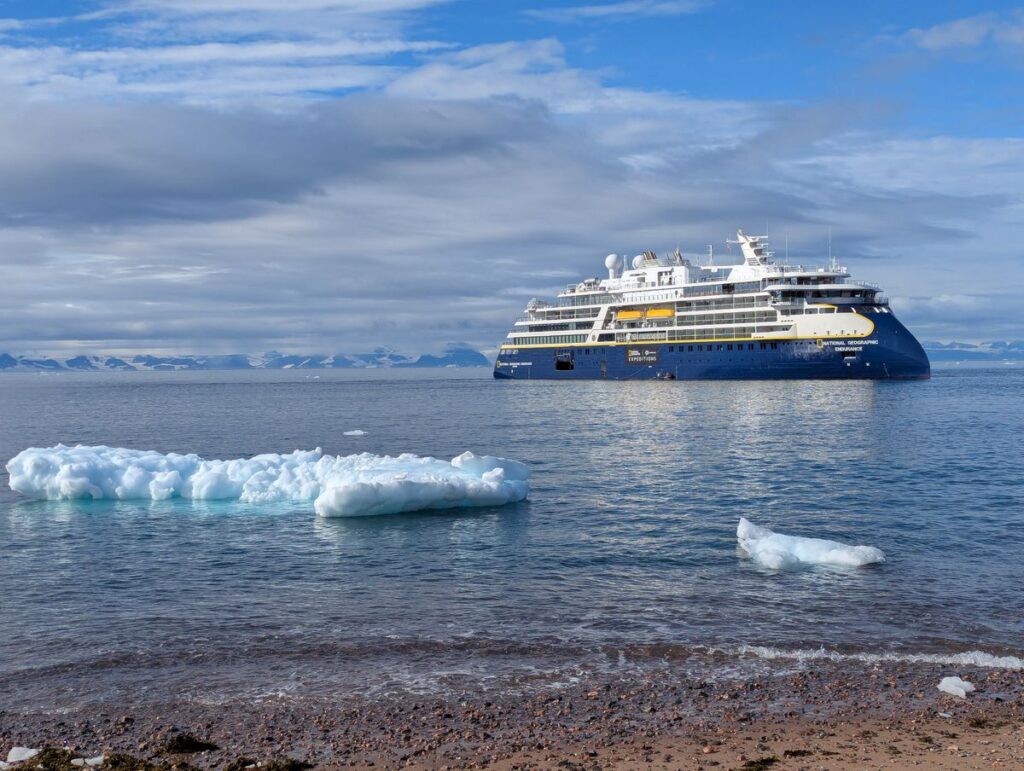
We had just finished listening to a lecture about scientific research being conducted on the Greenland Ice Sheet when an excited voice came over the public address system of the National Geographic Endurance. “Ladies and gentleman, the bridge team has spotted a polar bear on the sea ice. Please be as quiet as possible as you make your way to the outer decks, so as not to disturb the bear.”
I speed-walked to the front of the ship, joining dozens of other passengers in breathless silence as we marveled at the furry, four-legged creature skillfully making its way across the floes off the eastern coast of Greenland. Through binoculars and spotting scopes, we all held our breath as the massive, off-white animal gracefully ambled across the ice, stopping every few yards or so to lift its nose and sniff the air, hoping to pick up the scent of a seal.

One of many polar bears we spotted (from a safe and respectful distance) onboard the National Geographic Endurance in East Greenland (Photo Credit: Sarah Kuta)
It was the first polar bear we encountered during National Geographic-Lindblad Expeditions’ “Iceland’s Wild West Coast to East Greenland” cruise in mid-August. But it was far from the last. Over the course of 12 days, we saw dozens of the iconic creatures, as well as musk oxen, Arctic hares and countless birds and whales—including a pod of elusive, rarely seen narwhals.
Beyond the wildlife, this adventurous voyage included otherworldly geology, sparkling icebergs, stunning fjord scenery, thunderous calving glaciers and thought-provoking conversations about everything from climate change to the history of European exploration in Greenland. Here’s what it was like.
Exploring Iceland and Greenland with National Geographic-Lindblad Expeditions
The “Iceland’s Wild West Coast to East Greenland” itinerary sails roundtrip from Reykjavík, a convenient starting point with nonstop flights from many North American cities. From there, the cruise heads toward the Westfjords, a rugged region that juts out from the northwest tip of Iceland. On our sailing, we cruised into Ísafjarðardjúp, a huge fjord system brimming with marine life, to visit the Dynjandi waterfall and the Vigor Island Heritage Farm and Nature Reserve.
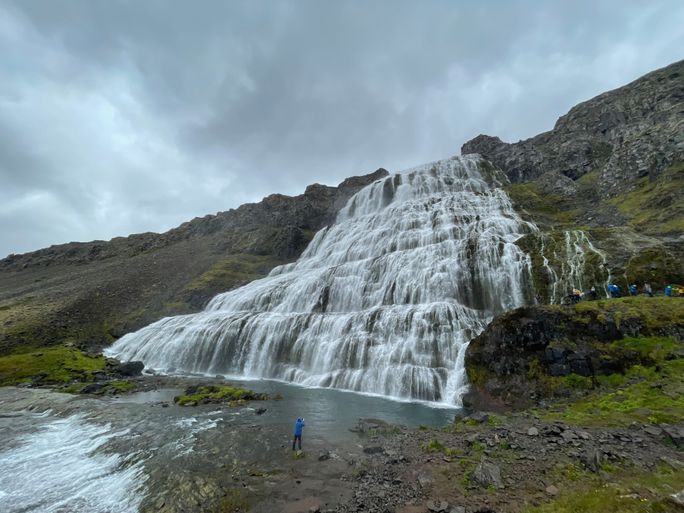
The Dynjandi waterfall in the Westfjords region of Iceland (Photo Credit: Sarah Kuta)
The ship then sails west across the Denmark Strait, the wide, iceberg-strewn channel separating Iceland and Greenland. After that, like any good expedition cruise, the rest of the trip is a mystery, with the weather and ice dictating the exact route. The goal, however, is to spend nearly a week exploring Northeast Greenland National Park—which, at more than 375,000 square miles, is the largest national park on the planet. We spent a morning in Ittoqqortoormiit, a tiny village with just 350 residents, but otherwise visited wild, uninhabited places.
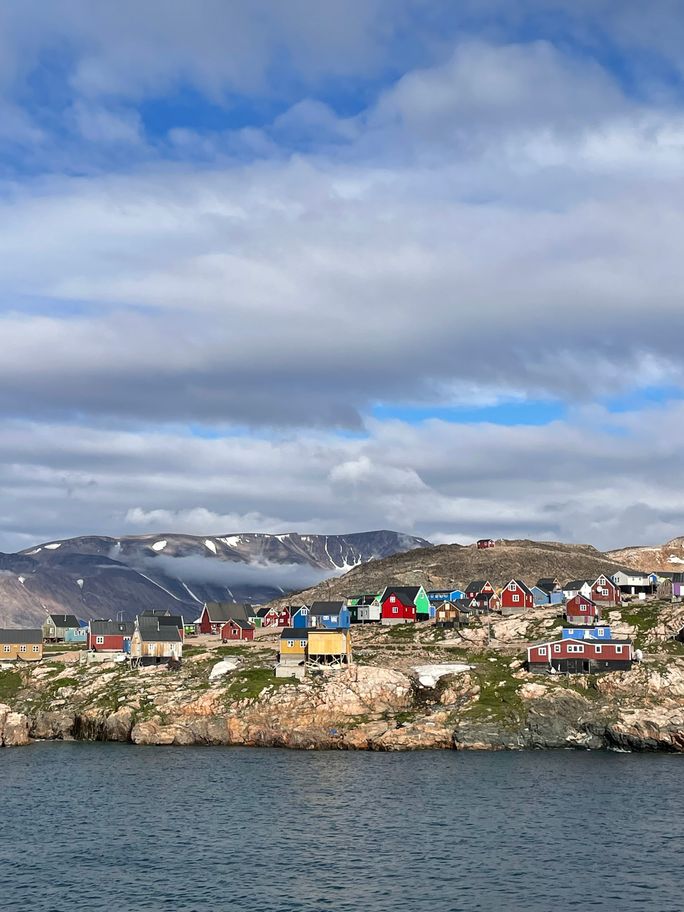
Ittoqqortoormiit, a small town in East Greenland with roughly 350 residents (Photo Credit: Sarah Kuta)
This particular itinerary is only offered in August and early September, which is when the sea ice along the coast of East Greenland has broken up enough to allow for shore landings. However, National Geographic-Lindblad Expeditions also offers numerous other itineraries in Iceland and around the Arctic.
Life Onboard the National Geographic Endurance
Launched in July 2021, the National Geographic Endurance is a truly beautiful home-away-from-home. It’s named after the Endurance, the three-masted wooden ship 20th-century British explorer Ernest Shackleton and his crew of 27 men sailed during the Imperial Trans-Antarctic Expedition, a bid to reach the South Pole by traveling across Antarctica on land. Famously, of course, the Endurance became trapped in sea ice in 1915 and eventually sank, leading to one of the greatest survival stories of all time.
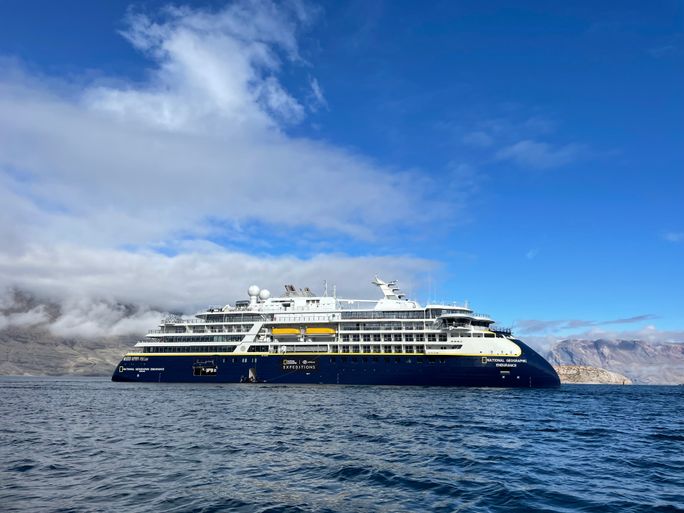
The National Geographic Endurance on a sunny day in East Greenland (Photo Credit: Sarah Kuta)
Fortunately for today’s travelers, the similarities stop at the name. With 76 cabins (including two newly added solo cabins), the National Geographic Endurance can accommodate up to 138 guests. It’s an ice-class Polar Code PC5 (Category A) vessel with a patented X-bow that helps it glide seamlessly through the water. For guests, this unique design ensures a smooth, comfortable ride, even when conditions are rough. Sea ice is no match for the vessel’s sturdy, reinforced hull, which means National Geographic-Lindblad Expeditions can take travelers to some of the most remote, rugged places on the planet.
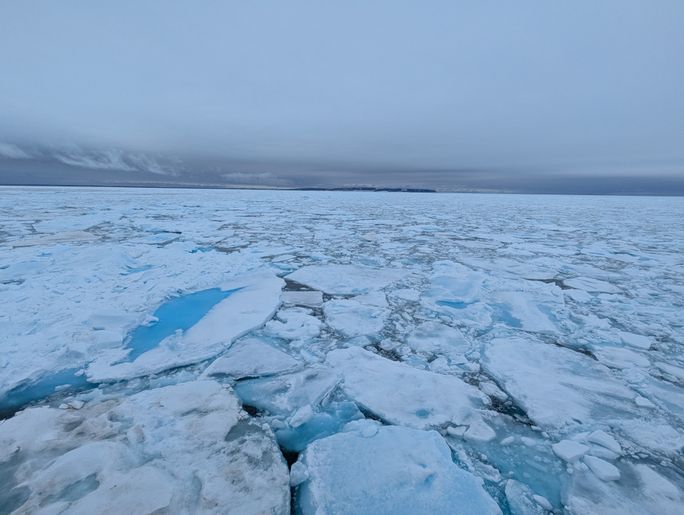
The National Geographic Endurance can sail through sea ice (Photo Credit: Sarah Kuta)
On my voyage, we cruised to 75 degrees north latitude—far above the Arctic Circle. One of my favorite pastimes was standing on the bow, looking down as the ship crunched through the wide, flat pieces of sea ice spread across the inky-black water.
“We always enjoy taking the ship to do what she was built to do,” Aaron Wood, captain of the National Geographic Endurance, told us during one evening’s briefing. “She is, of course, incredibly strong, incredibly capable. She’s really proven herself with regards to ice navigation.”
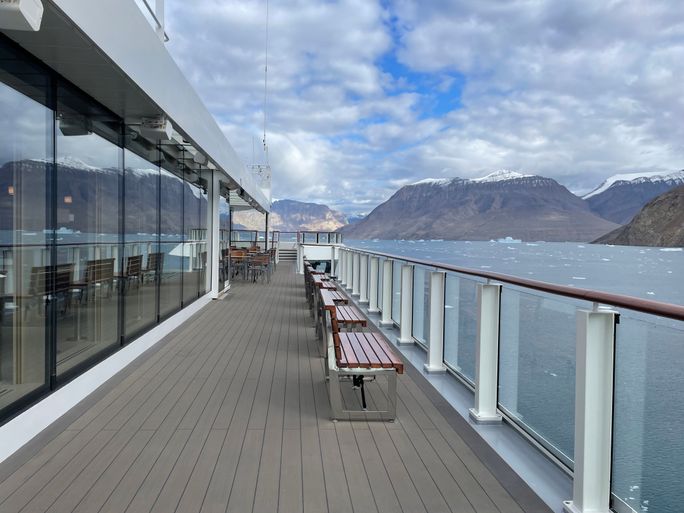
National Geographic Endurance had lots of beautiful spaces to enjoy the views (Photo Credit: Sarah Kuta)
The ship’s cozy vibes and abundant creature comforts are a sharp contrast to the harsh, unforgiving landscape just outside. I loved curling up with a cup of coffee and a book in the library, watching the waves while sweating in the two saunas and admiring the northern fulmars that trailed the ship while soaking in the two infinity hot tubs at the stern.
When we weren’t gearing up for shore landings, the Ice Lounge was the hub of all the action on the ship. This cozy-yet-high-tech living room was where our fearless expedition leader, Jon Fuhrmann, briefed us on the next day’s adventures and where other members of the expedition team offered insightful lectures and Q&A sessions. The space is large and filled with light, thanks to floor-to-ceiling windows on nearly all sides. It has a full bar and a variety of comfortable seating options, from half-moon-shaped couches to swiveling chairs. Each group of seats has its own large TV, a clever design choice that means no one ever has to strain to see what’s on the screen.
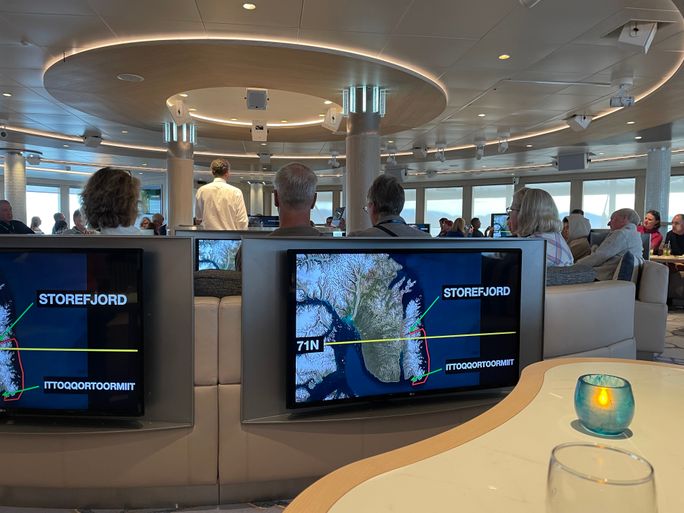
The Ice Lounge onboard the National Geographic Endurance is the central hub for lectures, briefings and cocktail hour (Photo Credit: Sarah Kuta)
The National Geographic Endurance also has a spacious spa, a well-equipped fitness center, a yoga studio/stretching room and a gift shop featuring useful gear and a curated selection of artisanal products.
Accommodations range from standard cabins with two large windows to spacious suites with balconies. The ship also has more than a dozen dedicated solo cabins, which offer 140 square feet of interior space, plus a balcony. All of the staterooms face outside, meaning you can watch the icebergs go by without having to ever leave your room.
Adventurous guests can also take advantage of the two geodesic glass igloos on the ship’s top deck. Passengers can reserve a one-night stay in one of these innovative, glamping-style pods once onboard. (For more details, read all about my experience sleeping in one of the igloos during the voyage.)
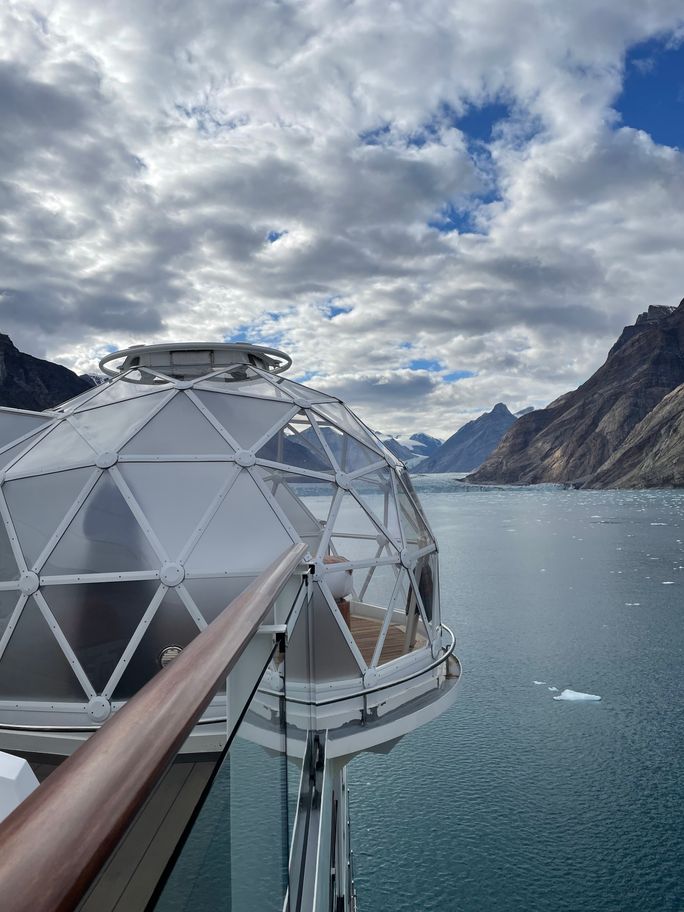
The igloos are cantilevered off the side of the ship. (Photo Credit: Sarah Kuta)
The National Geographic-Lindblad Expeditions Experience
Lindblad Expeditions has been taking travelers to some of Earth’s wildest and most far-flung destinations for more than 50 years—and it shows. Travelers reap the benefits of the company’s robust expertise in expedition-style travel, enhanced by more than 20 years (and counting) of partnering with National Geographic.
This was a true expedition cruise: Aside from a handful of scheduled stops, we mostly went wherever the conditions would allow. One afternoon, for instance, heavy fog rolled in during planned Zodiac cruises near Rathbone Island. So, instead, we listened to an insightful lecture about puffins and northern fulmars while the ship sailed on, then enjoyed an after-dinner landing and hike in Storefjord.

Mountain avens were still blooming in mid-August in East Greenland (Photo Credit: Sarah Kuta)
“There’s no real way of saying, ‘We’re going to go exactly here, here and here,’” Fuhrmann told us during one briefing early in the voyage. “When you talk about a plan A for a trip, then that is the best plan you have with the information that is available at that time. If we then move on to plan B or C or omega, then that doesn’t mean we are moving to a worse plan. It just means it’s the new best plan, given the updated information that we now have. That’s the nature of these evolving plans. We’re making the new best plan.”
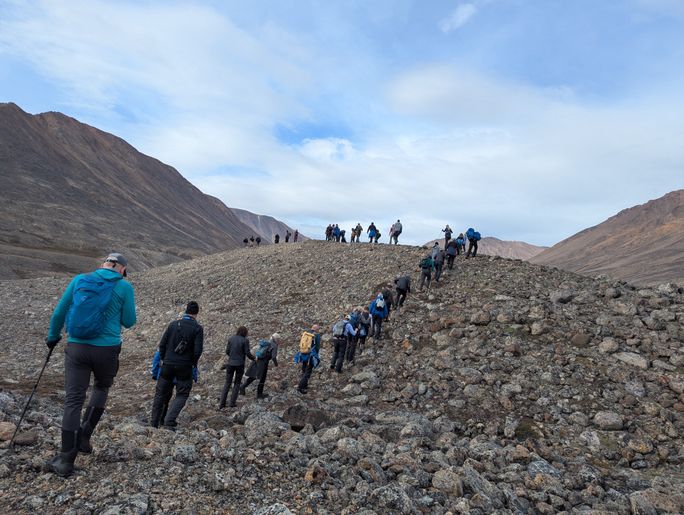
Hikes were available for travelers of all fitness and ability levels (Photo Credit: Sarah Kuta)
We hiked nearly every single day, taking a short Zodiac ride from ship to shore. The expedition team offered options for every fitness and ability level, from mellow “beachcomber” strolls to long, steep treks that often spanned four or five miles with lots of elevation gain. Rich Reid, our cruise’s certified photo instructor, and Annie Griffiths, the National Geographic photographer who joined our sailing, also organized outings specifically for guests who were eager to improve their photography skills. (Though there were options for everyone, guests do need to have good mobility and balance for climbing in and out of Zodiacs.)
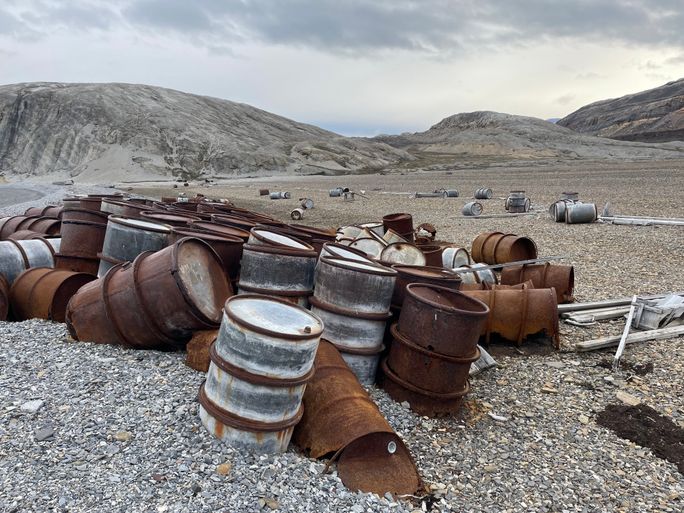
Artifacts from a World War II-era German weather station on Clavering Island in East Greenland (Photo Credit: Sarah Kuta)
One of my favorite treks took place on Clavering Island, where artifacts from a World War II-era German weather station are still strewn across the beach. Beyond, we spotted a family of musk oxen perched high on a hill, silhouetted against the sky. The ground was speckled with tiny, colorful flowers, including the fluffy white seed heads of mountain avens, the cheery blooms of yellow saxifrage and the vibrant purple petals of dwarf fireweed. We came across numerous animal bones, including the skull of an Arctic fox, a stark reminder that even the most well-adapted creatures still have a tough time surviving in the Arctic.
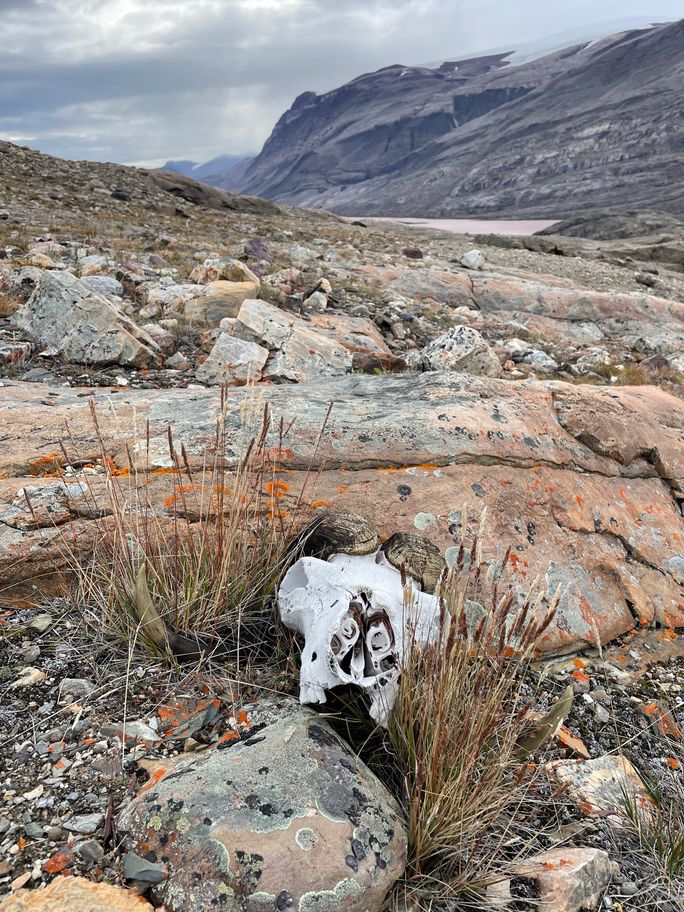
The Arctic is a difficult place to live, even for well-adapted animals like musk ox (Photo Credit: Sarah Kuta)
When landing wasn’t an option, we took scenic Zodiac cruises through towering icebergs, with the onboard naturalists providing informative commentary on what we were seeing. One of my all-time favorite moments came during one of these Zodiac cruises, an hour-long after-dinner outing near Waltershausen Glacier. We were getting ready to head back to the ship when, suddenly, the hulking whitish-blue mass emitted a deep rumble. We turned our heads just in time to see a massive section of the glacier’s face calve off, sending a shower of ice into the water below. (Safety is paramount for National Geographic-Lindblad Expeditions, so we were a good distance away but could still admire the natural spectacle.)

When landings were not possible, travelers can still get out and explore on Zodiac cruises (Photo Credit: Sarah Kuta)
The National Geographic Endurance also has a fleet of sturdy, inflatable yellow kayaks onboard. We took advantage of them one afternoon near Nordenskiöld Glacier, listening to the enormous icebergs crackle and pop as the water shimmered in the sunlight. And though I opted not to participate, I had a good time watching many of my fellow travelers dive into the icy waters of the North Atlantic during the “polar plunge” one afternoon.
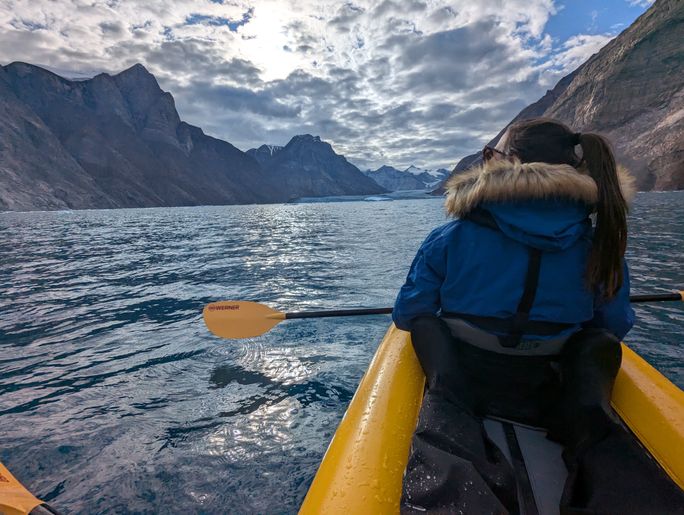
National Geographic Endurance has a fleet of inflatable yellow kayaks available for guests to use (Photo Credit: Sarah Kuta)
All excursions started at Base Camp, a specially designed hub featuring lockers where guests could store their muck boots and other warm-weather gear between landings. From large exits on both sides of the ship, we stepped carefully into waiting Zodiacs, always wearing life jackets and using a firm “sailors grip” with the crew members helping us. When we returned, we scrubbed our muck boots thoroughly to reduce the risk of transporting any harmful pathogens from landing site to landing site.
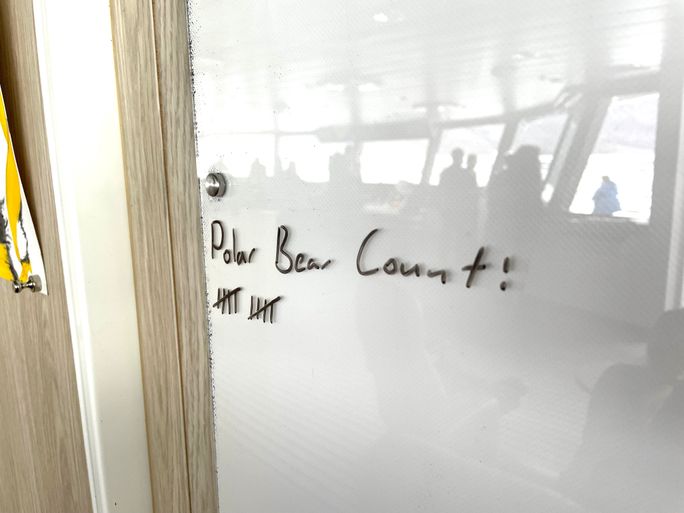
Polar bear sightings were a major highlight of the voyage (Photo Credit: Sarah Kuta)
Even when we weren’t out exploring, there was still plenty of action on the ship. Whenever the bridge team spotted something interesting—a school of fish that had attracted dozens of whales and dolphins, for instance—they made an announcement and encouraged guests to head to the bridge. The National Geographic Endurance has an open bridge policy, meaning anyone can hang out with the captain and the officers at any time, so I often popped up just to see what was happening, even when there weren’t any animals on the horizon.
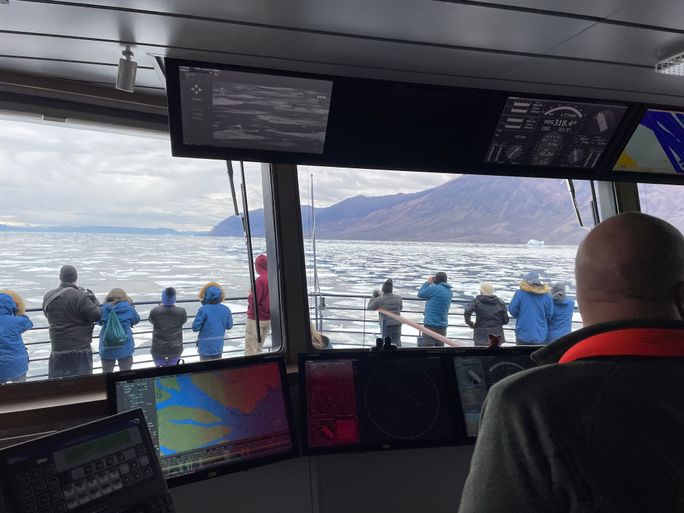
Guests hang out in the bridge and look for wildlife on National Geographic Endurance (Photo Credit: Sarah Kuta)
The expedition team also kept us busy and engaged with a full line-up of lectures. Offered in the Ice Lounge, these presentations covered topics like how to tell the difference between male and female polar bears; the status of gyrfalcons and peregrine falcons; and a history of Knud Rasmussen’s Thule Expeditions in Greenland in the early 20th century. Griffiths also shared stories and images from her four decades as a National Geographic photographer, and Inuk cultural ambassador Innuteq Kriegal shared what it’s like to live in Greenland.

With so much daylight, after-dinner Zodiac landings were a common occurrence in East Greenland (Photo Credit: Sarah Kuta)
Because there are so many hours of daylight above the Arctic Circle in August, we often went back out for landings or Zodiac cruises after dinner. On other nights, a handful of guests made their way up to the Ice Lounge for a nightcap after dinner. One evening, the expedition team hosted a movie night, complete with popcorn and a screening of Netflix’s “Against The Ice,” based on the true story of a 1909 expedition in Greenland. Toward the end of the voyage, there was also a lively performance by the aptly named crew band, the Shackletunes. But, otherwise, it was early to bed so we could be well-rested for the next day’s adventures.
Fueling Up with Locally Sourced Food and Drink
Guests aboard the National Geographic Endurance never go hungry, thanks to the hard work of executive chef Sara Henstam and her team. Overall, the company is committed to using fresh, locally sourced food and sustainable seafood for all of its shipboard meals.
Two Seven Zero
The ship’s main restaurant is Two Seven Zero, a spacious traditional dining room with indoor and outdoor seating. Breakfast is a hearty buffet, with the option to order freshly prepared dishes like omelets and tofu scrambles from the kitchen. Lunch and dinner are served table-side in Two Seven Zero, with a few exceptions.
Dinner was served buffet-style on the very first night of the voyage, as well as during an incredibly delicious Pinoy feast in honor of the ship’s many Filipino crew members. The evening’s dinner menu was typically printed and posted outside Two Seven Zero each morning, and guests were encouraged to indicate their preferred entree selection on a sign-up sheet below.
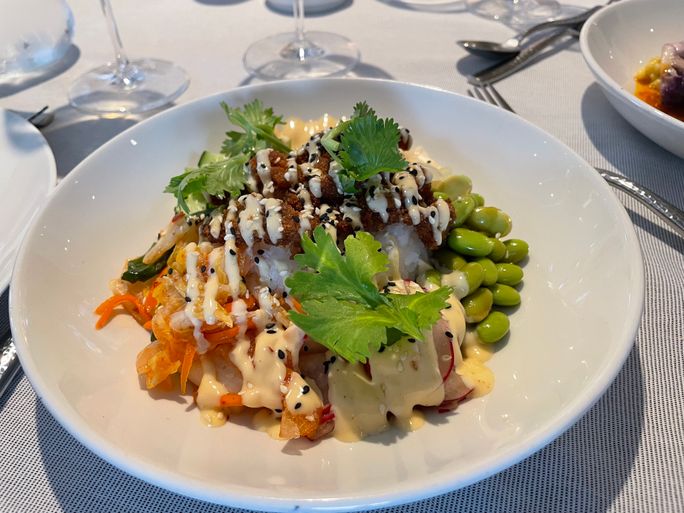
Breakfast, lunch and dinner are available at Two Seven Zero, the main restaurant on National Geographic Endurance (Photo Credit: Sarah Kuta)
There is no dress code aboard the National Geographic Endurance, not even for dinner, so most guests wore casual, comfortable clothes at all times.
C. Green’s
The National Geographic Endurance also has a second, smaller restaurant on Deck 8 near the library called C. Green’s. C. Green’s is short for Charlie Green, the British ship’s cook who prepared meals for Shackleton and his men aboard the Endurance. This bright, multi-purpose space has a bar and a smattering of cafe-style tables where guests can order lighter fare for breakfast and lunch. Snacks—like mixed nuts, crackers, dried fruits and pretzels—were nearly always available at C. Green’s, too.
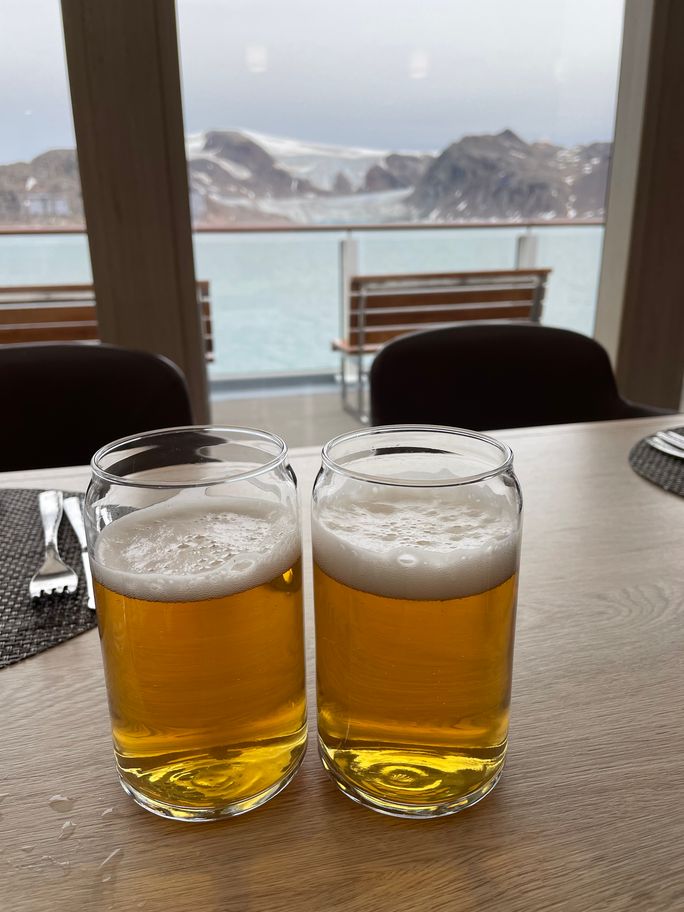
C. Greens is a breakfast and lunch restaurant on National Geographic Endurance (Photo Credit: Sarah Kuta)
Each day, the culinary team also set up an elaborate afternoon tea station, complete with scones, pastries and other goodies. One day, they riffed on “afternoon tea” and hosted an outdoor barbecue featuring hot dogs and beer. Another, they offered traditional Swedish pancakes with lingonberry jam and ice cream.
Drinks and More
There are two conveniently located self-serve beverage stations available to guests 24 hours a day—one in the Ice Lounge and the other in C. Greens. At each one, guests will find a high-tech Melitta espresso machine that can whip up perfect lattes and macchiatos in just a few seconds. Cleverly, the company offers both cozy earthenware mugs and flat-bottommed, lidded, metal travel mugs, in case guests want their hot drinks to be more portable.
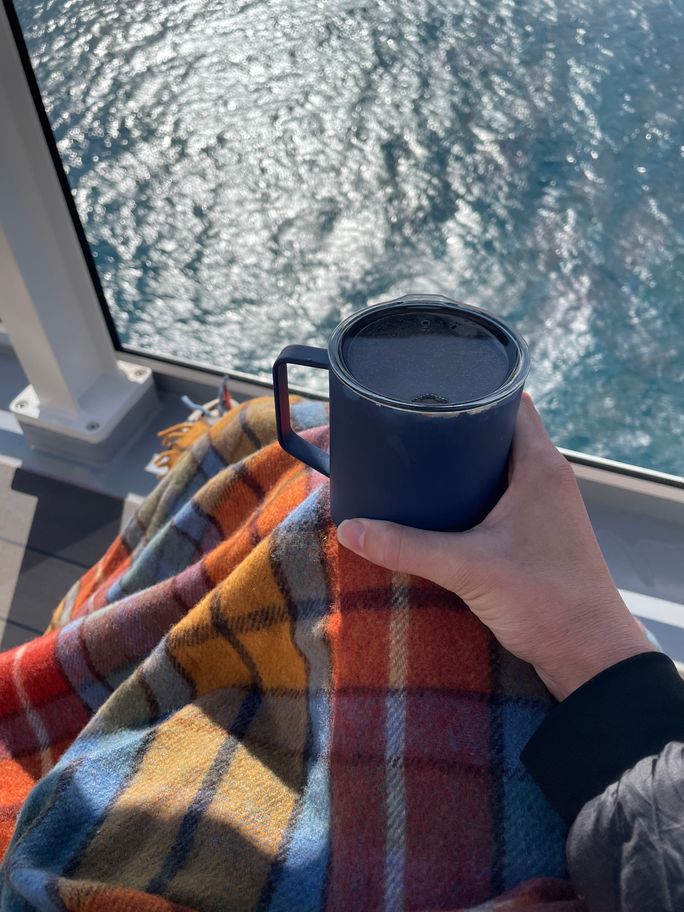
Enjoying a sunny day with a coffee on National Geographic Endurance (Photo Credit: Sarah Kuta)
Nearby, there’s a mini fridge full of canned beverages like beer and sparkling water, as well as glass jars containing an endless supply of freshly made cookies. Each beverage station also has a dispenser for chilled or sparkling water.
Airport-style water bottle refill stations are also available throughout the ship, and guests receive branded water bottles in their cabins at the start of the trip.
Hors d’oeuvres were also available each evening during the daily briefing and recap in the Ice Lounge. After excursions, a friendly member of the bar team was typically waiting at Base Camp to welcome guests back to the ship with a warm drink, like hot cocoa, cider or tea.
National Geographic Endurance has two bars, one in the Ice Lounge and the other in C. Greens. Beer, wine, cocktails and spirits are included in the cruise fare, with premium liquors available for an extra fee.
Chef’s Table
A standout experience was the Chef’s Table, an immersive, multi-course meal offered on a long wooden table at C. Green’s. Each day, around two-dozen guests received an invitation to join the Chef’s Table that evening, until everyone onboard had a chance to participate. The Chef’s Table is included in the cruise fare, with optional wine pairings available for an additional fee.
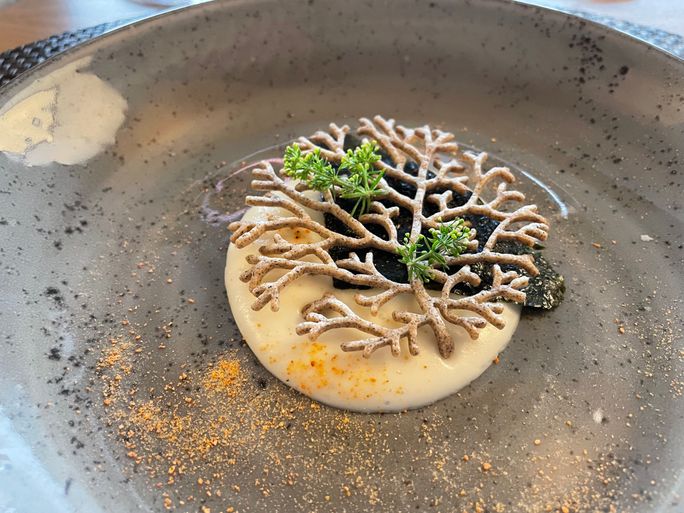
The Chef’s Table was a memorable experience on National Geographic Endurance (Photo Credit: Sarah Kuta)
The menu—which was exquisite—was thoughtfully curated to raise awareness about the effects of climate change. One bite, called “Let’s Keep Our Oceans in Balance,” featured smoked zucchini wrapped in a crispy “fishing net,” as well as rutabaga-parsley puree, beetroot bits, carrot-lemon caviar and chive oil. Dessert, titled “Ode to the Bees,” consisted of a large pavlova in the shape of a beehive, as well as lavender-lemon ice cream, fresh fruit, berries and adorable sugary bee candies. A member of the culinary team introduced each course, explaining the significance behind each one.
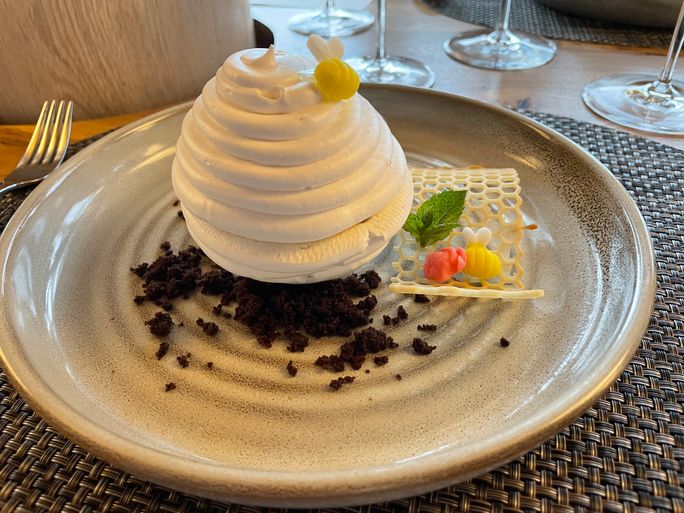
The “Ode to the Bees” at the Chef’s Table on National Geographic Endurance (Photo Credit: Sarah Kuta)
Who’s Onboard? Curious Travelers Going Beyond the Bucket List
Most of my fellow passengers were retirees who were enjoying their golden years after busy careers as doctors, lawyers, consultants, engineers, researchers and teachers. There was one family with young kids onboard, as well as a handful of 20- and 30-somethings on vacation with their parents.
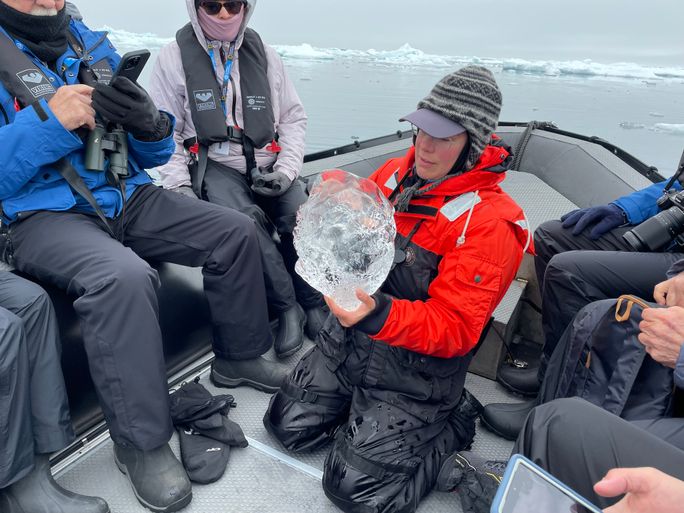
Expedition guide Kerstin Langenberger explains the difference between glacial ice and sea ice on a Zodiac cruise (Photo Credit: Sarah Kuta)
Overall, guests were curious and whip-smart, asking insightful questions that went far deeper than the basics. They were heavily interested in science and history, with a robust appetite for any information the expedition team could provide.
Though I encountered a handful of politically conservative folks onboard, the vast majority of guests were left-leaning. (A panel discussion about climate change, for instance, was very well-attended.) I chatted with several LGBTQ couples who felt totally at ease and comfortable onboard, suggesting that National Geographic-Lindblad Expeditions has successfully created a welcoming and inclusive environment.

Watching for wildlife on National Geographic Endurance (Photo Credit: Sarah Kuta)
A few folks were traveling with National Geographic-Lindblad Expeditions for the first time. However, the vast majority of guests were deeply loyal repeat customers who had already sailed with the company numerous times. I met several super fans who have been traveling with Lindblad for decades and wouldn’t dream of traveling with anyone else; several excitedly told me they were already booked on one of the company’s new European river cruises, which are slated to debut in April 2026.
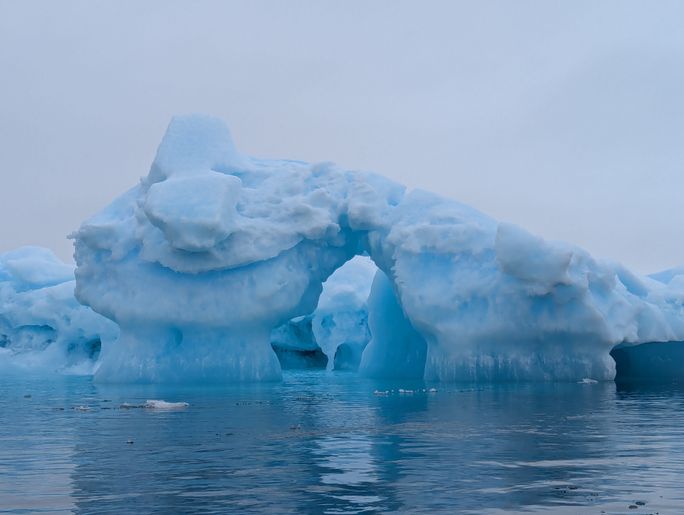
Icebergs form beautiful shapes off the coast of East Greenland (Photo Credit: Sarah Kuta)
Most travelers on my trip had already been to Antarctica. Once they’d checked the White Continent off their bucket lists, they were eager to explore other, lesser-known destinations with similar vibes—and the Iceland/East Greenland itinerary delivered in spades. If your clients have already done Antarctica—and, importantly, loved it—this voyage is the perfect follow-up to suggest next.
Overall, the cruise was the perfect blend of adventurous outings, cozy vibes, abundant wildlife, delicious cuisine and meaningful conversations. It’s ideal for travelers who are ready to get outside their comfort zone—without sacrificing on comfort.
For the latest travel news, updates and deals, subscribe to the daily TravelPulse newsletter.

